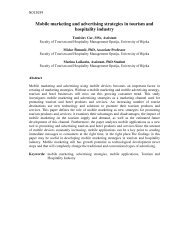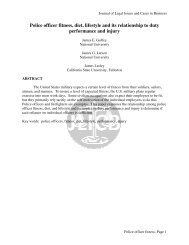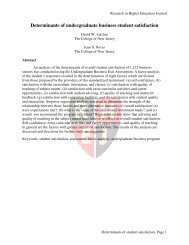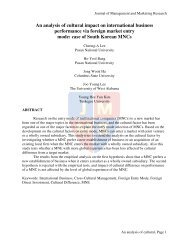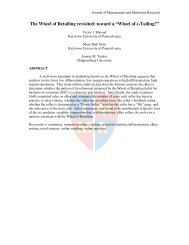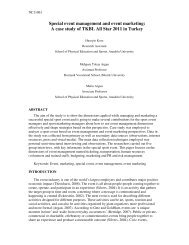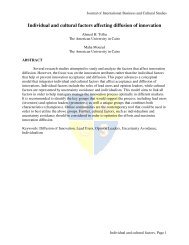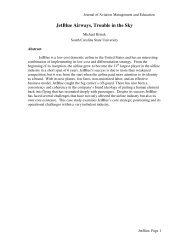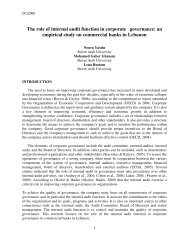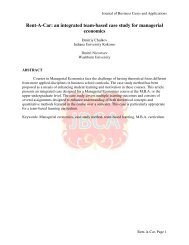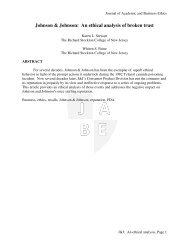Need-Based Segmentation Analysis of University Career Services ...
Need-Based Segmentation Analysis of University Career Services ...
Need-Based Segmentation Analysis of University Career Services ...
You also want an ePaper? Increase the reach of your titles
YUMPU automatically turns print PDFs into web optimized ePapers that Google loves.
Research In Higher Education Journal<br />
Sampson, Carr, Panke, Arkin, Minvielle, & Vernick, 2003; Venable, 2007), the effectiveness <strong>of</strong><br />
parents and career services staff jointly motivating students to make use <strong>of</strong> career services<br />
(Harris & Jones, 1999), men’s reasons for and for not seeking career counseling and other<br />
career-related services (Rochlen & O’Brien, 2002), advertising career counseling services to men<br />
(Rochlen, Blazina & Raghunathan, 2002), and stronger UCSC embedding within postsecondary<br />
institutions, e.g., the curriculum model (making career services part <strong>of</strong> course provision) (Watts,<br />
2006).<br />
A study that provides a good illustration <strong>of</strong> both the need for career services and the<br />
problem <strong>of</strong> getting students to participate in UCSCs is McCorkle et al. (2003). These researchers<br />
examined the extent to which marketing students have “self-marketing” skills, i.e. are able to<br />
apply what they have learned about marketing to their own job search process. First, despite their<br />
superior knowledge <strong>of</strong> marketing, they found that marketing majors were no better prepared for<br />
their job search than other business majors. Second, with the exception <strong>of</strong> networking with<br />
potential employers, less than 50% <strong>of</strong> junior students actually participated in available job-search<br />
activities such as seminars on résumé writing, trade or pr<strong>of</strong>essional club organizations and<br />
seminars on job search techniques. Third, seniors, for the most part, were better prepared for job<br />
search than juniors (e.g., many had greater knowledge <strong>of</strong> jobs/career fields) with one notable and<br />
disturbing exception−use <strong>of</strong> career services. The authors found that seniors are using career<br />
services slightly less than juniors. Drawing on interviews and other qualitative data, they<br />
conclude that many senior-level students are “do not consider the career services to be <strong>of</strong> much<br />
assistance,” (McCorkle et al., 2003, p. 202) and most “business schools would likely be appalled<br />
to find the proportion <strong>of</strong> their students who fully use the career development resources at their<br />
career services <strong>of</strong>fices,” (McCorkle et al., 2003, p. 204-5).<br />
In summary, prior studies have focused on ways <strong>of</strong> using information communication<br />
technology to increase the effectiveness and student use <strong>of</strong> UCSCs, gender-specific<br />
psychological reasons for and for not using career services, the treatment effects <strong>of</strong> advertising<br />
brochures, and options for more tightly embedding UCSCs on campuses. What are missing from<br />
the literature are empirical studies that investigate the different underlying needs and preferences<br />
that drive student usage <strong>of</strong> career services.<br />
One exception is Sampson et al., (2003) who examined need-based Internet websites in<br />
career services and thus is particularly relevant to the current study. Their research suggests the<br />
motivation for a website user to continue using a website is based on the degree <strong>of</strong> success a user<br />
has navigating that website for resources and/or services (Sampson et al., 2003). As such they<br />
advocate a website development process focusing more on meeting specific user needs and site<br />
content rather than on application <strong>of</strong> technology. In order to effectively implement this process,<br />
they indicate site designers need to be able to answer the following three questions, “Who should<br />
the website serve? What are the needs <strong>of</strong> the users? What resources are available (or should be<br />
available) to meet user needs?” (Sampson et al., 2003).<br />
Unfortunately, in regards to “who” the website should serve, organizations have a<br />
tendency, for the sake <strong>of</strong> efficient service delivery, to lump their users together (e.g., students,<br />
parents, pr<strong>of</strong>essionals, etc.) based upon some similar characteristic (e.g., age income, occupation,<br />
etc.). Therefore, the organization may not focus on the specific needs <strong>of</strong> specific user groups.<br />
Sometimes an organization is unaware <strong>of</strong> the process by which it distills the complexity <strong>of</strong> the<br />
population they serve into simple categories (Sampson et al., 2003, p. 9). Thus, these authors<br />
advocate the use <strong>of</strong> primary (focus groups, and surveys) and secondary research to help identify<br />
an organization’s users, their needs and the resources needed to satisfy their needs.<br />
<strong>Need</strong>s-<strong>Based</strong> <strong>Segmentation</strong> <strong>Analysis</strong>, Page 5



